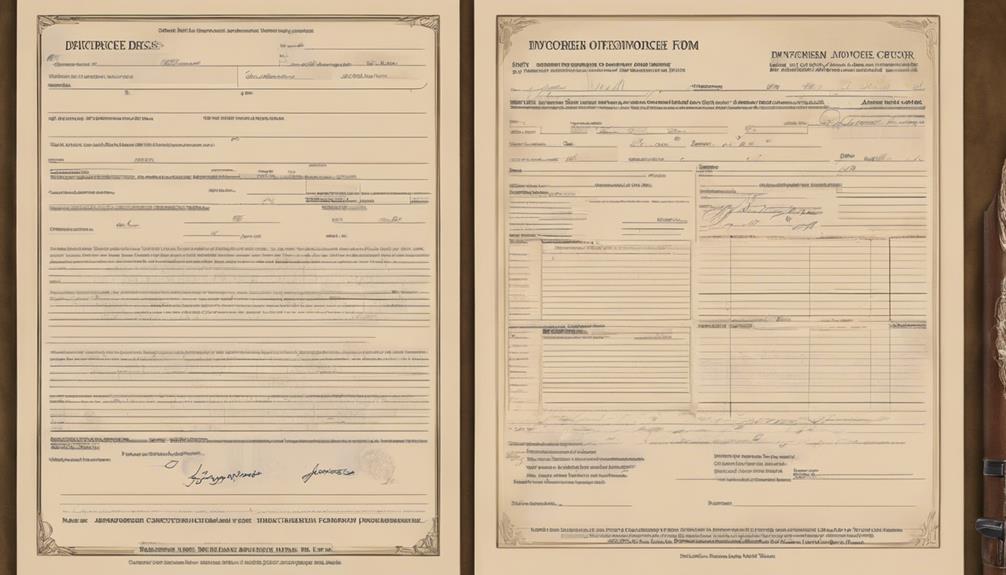In the United States, did you know that approximately 45% of marriages end in divorce? It is important to understand the details of a divorce decree to successfully navigate through this complex process.
In this guide, we break down the essential components of a divorce decree for cases without children, providing a comprehensive overview of the legal requirements and steps involved.
Whether you're considering a divorce or already in the midst of one, this guide offers valuable insights to help you navigate this significant life transition with clarity and confidence.
Key Takeaways
- Complete required forms accurately for a finalized divorce decree.
- Understand legal terms like alimony, equitable distribution, and custody.
- Draft decree with details on property division, support agreements, and name changes.
- Use testimonies and affidavits to support claims and decisions in the decree.
Required Documentation for Divorce Decree
In preparing the required documentation for a divorce decree, we must ensure that all necessary forms are accurately completed and signed by both spouses. The Final Decree, signed by the judge, is a pivotal document in formalizing the dissolution of the marriage.
Alongside this decree, supporting documents like the marital settlement agreement, parenting plan (if applicable), and financial disclosures play a crucial role in outlining the agreed terms and arrangements between the parties. Additionally, proof of service of process is essential to demonstrate that both spouses have been properly notified of the divorce proceedings.
Including any other relevant court filings further strengthens the completeness of the divorce decree documentation. Both spouses' signatures on the decree signify their acknowledgment and acceptance of the terms therein, facilitating a smoother finalization of the divorce process.
Attention to detail and accuracy in compiling these documents are paramount to ensure a comprehensive and legally sound divorce decree.
Understanding Legal Terms in Decree

Navigating the intricate web of legal terms within a divorce decree can be a daunting task for many individuals. When drafting your decree, it's crucial to grasp terms like 'Petitioner' and 'Respondent,' distinguishing the filing spouse from the other.
Understanding 'community property' (assets acquired during marriage) and 'separate property' (assets owned pre-marriage) helps clarify asset division. Additionally, terms like 'alimony' or 'spousal support' outline post-divorce financial responsibilities. 'Equitable distribution' ensures a fair split of assets and debts.
For couples without children, terms like 'custody,' 'visitation,' and 'child support' are pivotal even if not applicable. Seeking legal advice can aid in deciphering these terms and ensuring your decree aligns with the court order.
Steps to Drafting Your Decree
Transitioning from understanding legal terms in your decree, we now move on to the essential steps involved in drafting your divorce decree.
When drafting your decree, it's crucial to consider the court's requirements and ensure that all necessary details are included. Start by clearly outlining the division of property, including real estate, vehicles, and financial accounts.
Be specific about any agreements regarding spousal support or alimony, making sure to detail the duration and amount to be paid. Additionally, address debt allocation between both parties, whether it pertains to credit card debt or loans.
It's important to specify any desired name changes post-divorce and include provisions for other relevant matters like retirement account division or changes in insurance coverage. By carefully documenting these aspects, you can create a comprehensive decree that meets legal standards and ensures a smooth transition for both parties.
Testimonies and Affidavits in Divorce

Testifying under oath and providing written affidavits play crucial roles in divorce proceedings, serving as vital tools to substantiate claims and establish facts. Testimonies in divorce cases are firsthand accounts given under oath, offering insight into the circumstances surrounding the divorce. Affidavits, on the other hand, are sworn statements put in writing, providing a documented record of facts relevant to the case. These testimonies and affidavits help to validate allegations, clarify information, and support decisions within the divorce decree. By ensuring that all testimonies and affidavits are truthful, accurate, and pertinent to the case, the integrity of the divorce process is upheld, leading to a fair and just resolution. Witnessing the emotional weight of these testimonies and affidavits can be challenging, yet they are essential components in navigating the complexities of divorce proceedings.
| Testimonies | Affidavits | Divorce |
|---|---|---|
| Firsthand accounts given under oath | Sworn statements put in writing | Vital tools in divorce proceedings |
Post-Divorce Name Change Order
After finalizing a divorce, individuals may seek a post-divorce name change order to legally change their name. This order can be crucial in helping individuals transition smoothly into their new lives.
Here are three essential points to consider when navigating a post-divorce name change order:
- Legal Services: Seek guidance from legal professionals or services specializing in family law to ensure the name change process complies with the legal requirements set forth by the Supreme Court and the Texas Family Code.
- Court Approval: The name change order must be approved by the court to be legally binding. It's vital to follow all the specific procedures and requirements outlined by the court to facilitate a successful name change.
- Updating Identification Documents: Once the name change order is granted, individuals can utilize it to update crucial identification documents like driver's licenses, passports, and social security cards to reflect their new legal name accurately. This step is essential for maintaining consistency and authenticity in personal identification.
Frequently Asked Questions
How Do You Get Over a Messy Divorce?
We heal from a messy divorce by seeking therapy, practicing self-care, and leaning on a supportive network. Engage in activities that bring joy and focus on personal growth. Remember, we're in this together.
How Do You Gracefully Divorce?
Navigating divorce gracefully is like dancing through a storm; it requires communication, empathy, and compromise. Seek mediation, consider fairness, and create a detailed agreement together. Approach the process with compassion and focus on positive growth.
How Do You Make a Divorce Difficult?
We create a difficult divorce by prolonging conflicts, refusing cooperation, hiding assets, manipulating emotions, or using children as pawns. Our actions can escalate tensions and complicate the process. Instead, open communication and cooperation can lead to a smoother resolution.
How Do You Accept Divorce When You Don't Want It?
Accepting divorce when we don't want it can be tough. We must acknowledge our feelings, seek support, focus on self-care, explore new joys, and connect with others who understand. It's a journey we navigate together.
How can I modify a divorce decree template for children to fit my specific situation without children?
If you don’t have children and need to modify a free divorce decree template, simply remove all sections related to child custody, visitation, and support. You may also need to adjust any language pertaining to children’s needs or well-being. Review the template carefully to ensure it reflects your specific situation.
Conclusion
In navigating the complexities of divorce without children, remember that you aren't alone in this journey. Through proper documentation, understanding legal terms, drafting your decree, providing testimonies, and seeking a name change order, you can move forward with confidence.
Like a river flowing steadily towards the sea, trust that you have the strength and support to navigate this process and emerge stronger on the other side.
Stay resilient, stay informed, and remember that brighter days lie ahead.










